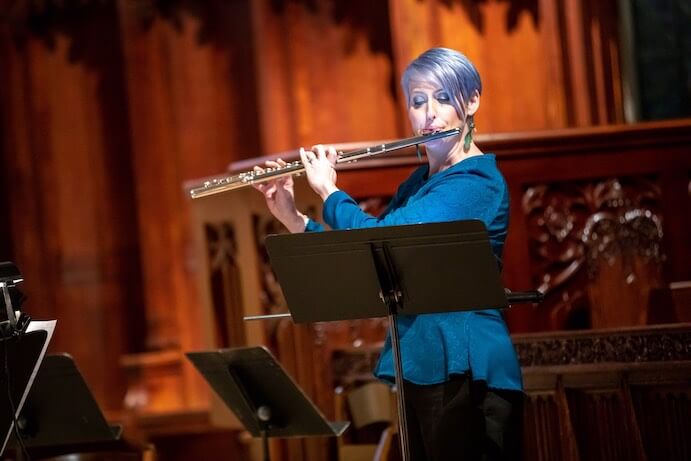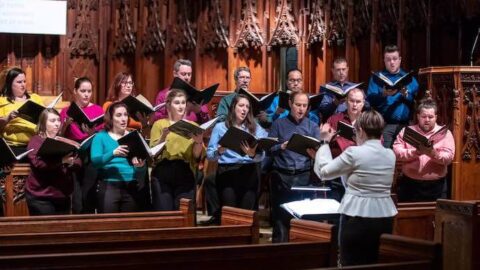On Sunday, November 3, 2019, Pittsburgh’s resident multimodal performing arts company, Resonance Works, opened the 2019-2020 season with a survey of modern and contemporary works by a global array of past and present composers. The program, entitled “the national anthems,” took its name and thematic basis from a work of the same name by Pulitzer Prize laureate David Lang. Described by the composer as a kind of meta-anthem, Lang’s work attempts to distill from a study of the world’s national anthems a common thread that illuminates our shared humanity rather than emphasizing the peculiarities that may separate us. In this way, Artistic Director Maria Sensi Sellner organized a program to complement Lang’s composition, aligned both with his work’s agenda of global unity and Resonance Works’ broader mission to promote racial and gender diversity in the concert hall.
The audience convened within the vaulted, gothic auditorium of the Charity Randall Theatre for the performance, which opened with Kaija Saariaho’s Tocar arranged for flute and harp. Flutist Lindsey Goodman and harpist Marissa Knaub Avon made expert work of Tocar before the twenty-voice Resonance Festival Chorus and string quartet took the stage to perform the evening’s eponymous work. the national anthems is stark, undulating, and mysterious, with fragmentary text written by the composer that unfolds over the course of five relatively short movements. Sellner’s ensemble was focused and performed intelligently. Due to the surprisingly dry acoustic of the hall, the presence of individual voices standing out occasionally became distracting and at times betrayed the synergy of the ensemble, but did not ultimately compromise the performance.

After a fifteen minute break, the chorus and strings returned to the stage with a broad survey of diverse and eclectic works (eleven in total). Arvo Pärt’s uncharacteristically kinetic and brief anthem Bogoróditse Djévo paired nicely with Gabriela Lena Frank’s similarly themed Ccollanan Maria. Sellner added a note of individuality to the latter by having the choir disperse throughout the hall, which added a satisfying, antiphonal dimension to the conclusion of Frank’s expressive work. Jorge Sosa’s Gitanjali #35 served as the evening’s world premiere, featuring soloist Charlene Canty, whose powerful soprano rose soaringly from the full ensemble of flute, harp and strings and vivified Sosa’s somewhat derivative work. James MacMillan’s So Deep offered luscious meditations upon the familiar text of Scottish poet Robert Burns, showcasing the capability of Sellner’s choir nicely and making a compelling contrast with three selections from Chen Yi’s Chinese Folk Songs.
It was from this point the program began to feel somewhat problematic in its organization. The inclusion of Silvestre Revueltas’ Mùsica de Feria was a curious non sequitur. The string quartet of Sandro Leal-Santiesteban, Ashley Freeburn, Jason Hohn, and Elise Feagley performed magnificently, but offered too striking a contrast to the rest of the program. Caroline Shaw’s meditation on the inscription at the base of the Statue of Liberty, Her Beacon Hand Beckons, clearly bolstered the theme of inclusion and acknowledgement of our shared history as immigrants, but might have been paired more effectively with Lang’s work, which by this point in the program felt almost forgotten. Armenian-American composer Mary Kouyoumdjian’s expressive and beautiful Groung told a tragic, folkish story about the strife of displaced peoples and acted effectively as a coda to Shaw’s work. This work, however, also felt interrupted by the following piece, Nkosi Sikelel’ iAfrika, a hymn composed by early 20th-century South African composer Enoch Sontonga that survives today as the national anthem of his homeland and a symbol of the anti-apartheid movement. While this piece and its composer helped show that the history of musical repertoire—indeed the composition of a national anthem—is not the sole domain of white Europeans, illuminating Sontonga and this particular work felt a bit too literal and out of place.

The following work, Florence Price’s Negro Folksongs in Counterpoint for string quartet, might adequately have fulfilled the sentiments suggested by the works of Sontonga and Revueltas. A skilled and highly sophisticated composer, Price was an African-American woman raised in Arkansas in the late 19th and early 20th centuries, where she was initially denied a public musical education by her hometown of Little Rock. Nonetheless, she enjoyed a prolific career marked by the premiere of her Symphony No. 1 in 1933 by the Chicago Symphony Orchestra, the first performance of a work by an African-American woman by any major American orchestra. Vivian Fung’s Kecak Attack! for choir a cappella rounded things out with an energetic lilt, demanding extended techniques from the choir in an emanation of an ancient Indonesian ritual dance. Still, this piece felt somewhat extraneous in concluding a program that might better have drawn a thread toward—rather than away from—the presentation of its title piece (the national anthems).
All in all, Resonance Works organized a thought provoking challenge to norms in concert programming, aimed with some success to illuminate suppressed or unspoken diversity in our musical past and present. By upholding their pledge to include a fifty percent makeup of women in their programmed composers, the continuing season promises a welcome infusion of sophistication and diversity in the music being heard across Pittsburgh’s classical music scene.
























